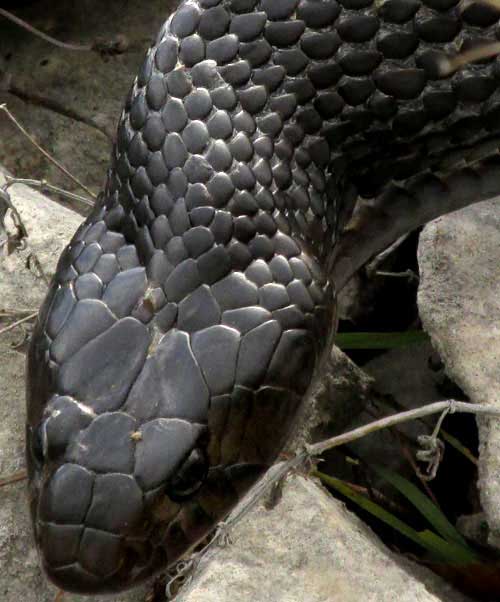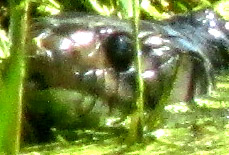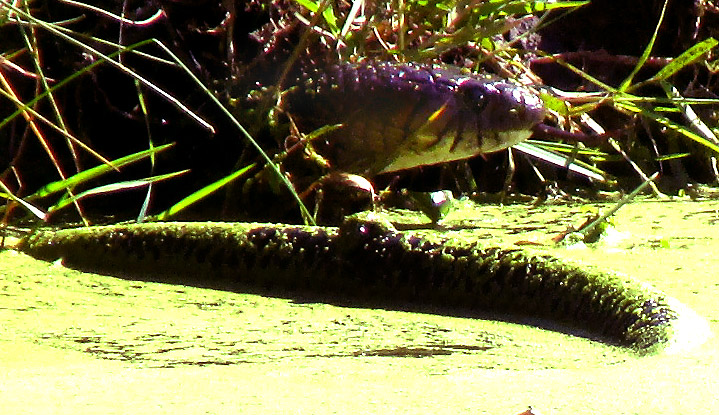Excerpts from Jim Conrad's
Naturalist Newsletter
from the April 19, 2018 Newsletter with notes taken two weeks earlier during a camping trip in Amistad National Recreation Area nine miles northwest of Del Rio, western Texas, on the border with Mexico; elevation ~369m (~1180ft), N29.465°, W100.964°
TROPICAL INDIGO SNAKE
At first glance Amistad's landscape looks flat, but when you're hiking you're constantly ascending or descending the shallow slopes of an unending network of gullies or arroyos. Atop the rises sometimes you find a pure stand of Sweet Acacia, and sometimes if you penetrate them they give way to a shoulder-high thicket of light-gray-leafed bush known as Cenizo. If the Cenizo-blanketed ridge is high and dry enough, inside the thicket it may open up and have only gravel, clumpgrass and maybe a few cacti. In one such spot I encountered the big snake shown below:

Notice that the snake's eye looks a little cloudy. I think he was about to molt, the eye's covering was coming loose, and this caused the snake to be somewhat blind. Whatever the case, the snake seemed to know that something was nearby, but apparently didn't see me, for after the above picture was taken he slithered around and passed right below me, not a foot away from my boot, providing the nice picture of his arrowhead-shaped head at the front of his massive body, shown below:

At first glance I'd have sworn that the snake was eight or at least seven feet long, but now having him right below me I could see that he was only five or six feet long (1.7m). My view from above enabled a close-up nicely showing the head's scale pattern -- in case there's any doubt about what this species is -- shown below:

This is the Tropical Indigo Snake, who we've met several times in Mexico {see below}. However, this is the first time I've been able to photograph an adult.
The US is home to two Indigo species, the Eastern Indigo, Drymarchon couperi, distributed throughout Florida and nearby contiguous states, and this one, Drymarchon corais*, in the US known as the Texas Indigo, and found in southern Texas. However, Drymarchon corais also occurs all through Mexico and Central America into South America, so it is better known as the Tropical Indigo. Until recently, all indigo snakes in the US were considered to be Drymarchon corais, but now the Florida population has been split off to constitute a different species.
In our pictures the snake is flattening his head. This is something the species does when individuals feel threatened, trying to make themselves look larger than they already are. Really upset individuals may also hiss and vibrate their tails, producing a rattling sound, which can be disconcerting in rattlesnake country like this.
Indigo snakes are active during the day, and ours was clearly foraging, looking for prey. I read that Indigos feed on a variety of mammals, birds, frogs and other snakes, including rattlesnakes and cottonmouths. They're even known to feed on young gopher tortoises, which is a little surprising, since Indigo snakes often use gopher tortoise burrows as shelter.

from the September 5, 2010 Newsletter issued from Hacienda Chichen Resort beside Chichén Itzá Ruins, central Yucatán, MÉXICO
SNAKE IN A BUCKET
Alex of the grounds crew approached the hut warily carrying a white bucket and I figured he was bringing me a snake. It'd be a little one, though, because the fellows are afraid of snakes. But I like those little ones since usually they're the most interesting. I was right. It was a juvenile, and like so many species it was pale below but dark above, with no lines, bands or blotches. However, some distinctive-looking black facial markings on the head gave me hopes for naming it. The snake made no attempt to bite or get away as I reached into the bucket. You can see the little fellow above.
A shot showing more of the body, including the black tail that was minus a couple inches of its tip, below:

Those black lines on the face and the black tail nicely matched pictures in Jonathan Campbell's Amphibians and Reptiles of Northern Guatemala, the Yucatán, and Belize. It's a juvenile Tropical Indigo Snake, DRYMARCHON CORAIS. The species' Spanish name is Arroyera de Cola Negra, or "Black-tailed Arroyo Snake," an arroyo being a small stream that's dry most of the time. With that black tail and lack of blueness, the Spanish name for our snake is more appropriate than its English name.
Back in the 70s my Zoology teacher back at the University of Kentucky, Dr. Roger Barbour, kept a big Florida Indigo he'd collected in Florida in a large metal, swimming-pool-like container near his office, and I remember that amazingly easy-going snake as being a very dark blue. However, Campbell describes adult Tropical Indigos in our area as having the front half of their bodies pale brown to olive-tan, becoming darker further back, so that the tail and about the last fourth of the bodies are blackish.
The thing about Indigo Snakes is that they can grow very large. The Florida Indigo is regarded as North America's longest snake, the record being 103.5 inches (262.8 cm, over 8.6 feet). In the Yucatan we have two species that grow longer than that, Boa Constrictors and Tiger Treesnakes.
Indigo Snakes eat frogs, lizards, other snakes, birds and mammals. They don't constrict their prey like Boas. They just rush and seize their prey, then swallow it alive. That's often the way you find an Indigo -- by its prey's distress calls as it disappears into the snake.
Alex's little Indigo had been found in the tourist area, so he couldn't be returned there. I laid him on the ground beneath my Zinnias. Within two seconds he'd slipped between the hut's foundation rocks, and I figure that that's a good place for him.

Thanks to a big landowner who, from inattention, lets his irrigation pumps run long after his fields are saturated, a certain little pond usually stays full of water, even when all others have gone dry. Though the waste of groundwater is inexcusable, wildlife in the pond's area benefits, like the above watersnake.
At 9:30AM the snake crossed a house-size sunny, scrubby expanse, possibly having visited a dried-up pond a stone's throw away. This was surprising, because the black snake was strikingly visible in the short, overgrazed, drought-killed grass, and a White-tailed Kite and a Red-tailed Hawk patrol this area constantly, both known to prey on snakes.
In the above picture, notice how two rows of scales on the snake's back form a kind of flat zone running atop the spine, collecting tiny Brazilian Watermeal plants, which must provide decent camouflage. The photo was taken at a distance, with the snake approaching. I anticipated a great shot of the head scales for identification purposes,  but then the camera's battery died, the dog saw the snake, freaked out, and the snake retraced his route. At the right, the head is shown larger and overexposed, to highlight the head scales.
but then the camera's battery died, the dog saw the snake, freaked out, and the snake retraced his route. At the right, the head is shown larger and overexposed, to highlight the head scales.

Above, the snake has returned to the far bank and looks around before leaving the pond. On the pond's far side, as the snake escaped across the parched grass, a picture was possible of the body mid-section, though the snake's head already had disappeared into a tangle of grass and scrub. Hare's the picture:

I had trouble with this snake, not making the connection of the vertical black stripes below the eyes with that of the immature snake seen in the previous entry, above. It took iNaturalist user "carl_sands" to recognize it as our old friend the Central American Indigo Snake, DRYMARCHON MELANURUS
from the May 26, 2007 Newsletter issued from from Sierra Gorda Biosphere Reserve, QUERÉTARO, MÉXICO
INDIGO AT MY KNEE
Above a cliff of outcropping limestone next to the lake I was hiking an overgrown cattle trail through scrub paying more attention to keeping my balance on the steep slope than anything. Then I saw it: Not a yard from my leg rose the front end of a massive, blue-gray snake between six and seven feet long, his head hooked forward and pointed at my right knee. My first thought was, "Well, I've been looking for you for a long time!"
For, it was a Tropical Indigo Snake, DRYMARCHON CORAIS, one of our largest snakes. Unfortunately, by the time I'd pulled off my backpack (I'd camped overnight in the area) and got my camera set up, the Indigo had slipped over the cliff. However, just a few feet away I found a shed skin, which I photographed next to my 12.5-inch long sandal for scale. You can see that image below:

Back at the casita I looked up the Indigo in Jonathan Campbell's herp book which previously I used in the Yucatan. It said that Indigos in the southern US have "... a reputation for being docile and mild-mannered. This is not true of tropical indigos, which are easily irritated to the point of inflating the throat and vibrating the tail, and often delivering a powerful, although nonvenomous, bite." I got a twang in my right knee when I read that.